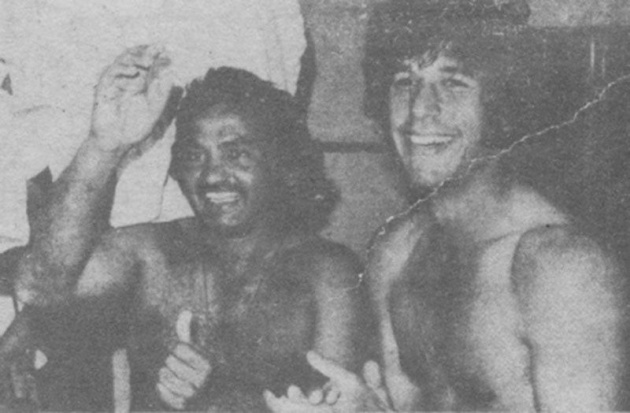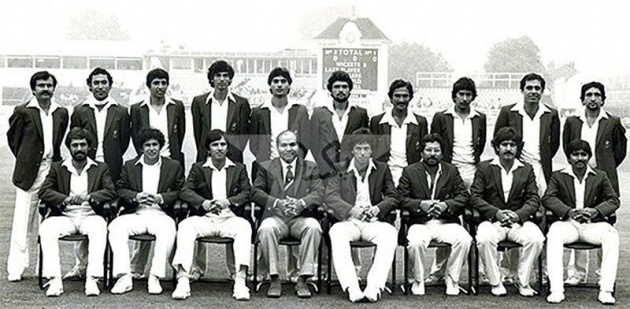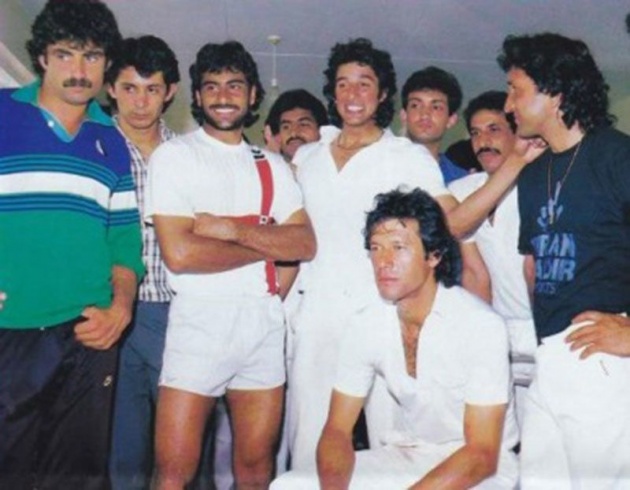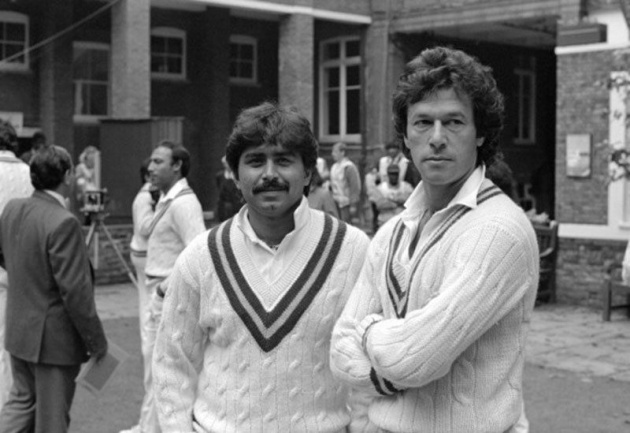
Till the appointment of Misbahul Haq as Pakistan’s cricket captain in 2011, former all-rounder, Imran Khan, was overwhelmingly remembered as the greatest captain ever to lead the Pakistan cricket side.
However, five years after Misbah’s elevation to the post of captaincy, he not only leveled the joint-record (of most Test victories as captain held by Imran and Javed Miandad), but, by the tail-end of 2015, Misbah has already added to his tally another 6 victories (compared to the 14 each by Khan and Miandad).
Misbah now has an impressive 20 Test wins under his belt, the most ever by a Pakistani Test captain.
But Misbah is a modest man. Whenever he is reminded of this feat of his, he almost always recoils and politely suggests that as a cricketer he is nowhere close to Khan or Miandad.
Though it has taken quite a while for Misbah’s prestige and fame (as skipper) to mushroom, there is now enough evidence to suggest that he may as well have become the country's greatest cricket captain.
Compared to the way Misbah’s fame as captain has slow-burned its way to the top, Imran Khan’s rise in this context was a lot swifter. But interestingly, both took over teams that were peppered with multiple problems.
Khan was appointed captain in 1982 at the age 0f 29. He had already established himself as a world class fast bowler and was on his way to becoming a quality all-rounder as well.
He was a regular member of the Pakistan team, having made his debut in the early 1970s as a lanky teenager.
Till his appointment, Khan had played his most formative cricket under the leadership of Mushtaq Mohammad who (between 1976 and 1979) became the country’s most successful Test skipper with 8 wins in 19 games.

However, in late 1979, Mushtaq was nudged out by the Pakistan cricket board (for losing form and ‘an advancing age’).
He was replaced by his friend and vice-captain, Asif Iqbal (who, ironically, was of the same age as Mushtaq, 36!).
Pakistan under Iqbal had a disastrous tour of India after which he promptly retired and was replaced by the then 23-year-old Javed Miandad.
Miandad’s appointment came as a surprise to the senior members of the team, so much so, that two years later (in early 1982), 10 regular members of the squad refused to play under him.
The rebellion was led by dashing opening batsman, Majid Khan, who, though, by then had lost much of his batting flair.
Another senior, Zaheer Abbas, sided with Majid and both convinced another eight members of the team to boycott Javed’s captaincy which they claimed was immature and ‘disrespectful’ to the seniors. Imran was one of the rebels.
The board sided with Miandad. But when a new-look Pakistan side almost lost a Test against a nascent Sri Lankan Test squad, Miandad agreed to step down on the condition that he would not play under Majid or Zaheer, both of who were expecting to be named captain after Miandad’s departure.
The board, in its pursuit to resolve the captaincy crisis, decided to think out of the box. It sprung a surprise by bypassing both Zaheer and Majid and named Imran Khan as captain.
Cricketing wisdom in those days suggested that fast bowlers never made good captains. However, this perception was somewhat negated when England’s quick bowler, Bob Willis, was made captain in 1982 and did quite well in his first series as skipper (against India in India).
Although Khan’s appointment took the players and the media by surprise, it baffled Khan too. After consulting with some of his closest friends (including legendary cricket commentator, Iftikhar Ahmad), Khan almost declined, only to accept the post just before Pakistan’s 1982 tour of England.
This meant Khan had to lead a team that was severely troubled by in-fighting and had in it some players who even refused to speak to each other.
What’s more, Khan hardly had any captaincy experience. He had only captained his university team at Oxford in the early 1970s.
However, in the next two years, Khan was more than successful in transforming the once bickering squad into a close-knit unit who turned winning into habit.

One of the main factors that contributed in helping Khan achieve this was the way his form as a bowler and batsman blossomed under pressure. Thus, he was able to win the respect of his teammates by leading from the front.
But Khan’s first era as captain almost entirely revolved around his imposing personality.
As an all-rounder he had rapidly evolved from being good to becoming great and this greatness permeated in him, a somewhat authoritarian and an almost dictatorial approach.

But, as long as he was able to perform well and lead from the front, the team willingly followed.
That is, until he broke down in 1983, and then quit cricket (for two years to rest a fractured shin).
With his exit the team just crumbled. In-fighting returned and so did players’ intrigues, again revolving around Zaheer and Javed, the two men who followed as captain after Khan’s exit.
Khan returned as skipper in 1986, his path cleared by Miandad’s second stepping-down moment – even though this time it was more voluntary.
Misbah too, took over a troubled squad. But unlike Khan, he was not even in the team when he was asked to lead.
Also, quite unlike the appointment of Khan, Misbah’s appointment as captain was initially a make-shift affair.
Misbah had made his Test debut in 2002 but was soon dropped. He was recalled to the side five years later in 2007.
In 2010, he was again dropped and was most likely to have remained in obscurity had three frontline Pakistani players (Salman Butt, Mohammad Asif and Mohammad Amir), not decided to earn some extra bit of money by indulging in spot-fixing during Pakistan’s 2010 tour of England.
Butt was captain at the time, replacing Shahid Afridi, who had conveniently decided to retire from Test cricket after his team lost the first Test on the same English tour.
Disgraced by the spot-fixing scandal, hit by the resultant long bans on the tainted players, and unable to resolve a simmering tussle between various groupings in the squad, the cricket board returned to Misbah and requested him to lead the side for the 2011 series against South Africa.
It was a one-series-deal; a series played in the UAE because at the time, no foreign team was willing to tour Pakistan which, ever since the mid-2000s, found itself wedged by a deadly wave of extremist violence and instability.
In 1982, Imran had arrived (as captain) with an aggressive plan to turn Pakistan into an attacking side. He largely succeeded because by 1988, Pakistan (under Imran’s second stint as skipper), not only shot up to become the No: 1 Test side in the ICC rankings, but the team was also being universally praised as one of the most exciting squads of the era.
Misbah’s approach on the other hand, was a lot more cautious. Because when he took over as captain, the once celebrated belligerence and flamboyant unpredictability of the Pakistan cricket teams under Imran (and then of the Pakistan sides that followed his retirement in 1992), had stopped being seen as things to rejoice or endear.
Match-fixing scandals, in-fighting, captaincy tussles coupled with the rising tide of extremist violence and political instability in Pakistan had eroded the team’s once celebrated status of being an excitingly unpredictable side. The moniker actually began to be seen with suspicion and dismay.
That’s why Misbah’s approach was almost opposite to that of Khan’s.
 Khan led from his heart.
Khan led from his heart.
Khan had instilled unity and spirit into a disjointed side by encouraging flamboyance and aggression. He lead with his heart and in the process, realigned the team’s implosive disposition by channelising the player’s emotions towards achieving nobler cricketing pursuits, instead of attaining only those driven by their myopic self-interests.
Khan saw himself as a warrior-captain. Bold, forthright, leading from the front, he explained anything that disagreed with his approach as cowardice.
He had admired captains like Australia’s Ian Chappell. But, whereas, Chappell too, was warrior-like, he also had a sharp mind.
Khan had a good cricketing brain, but it was nowhere as potent as the heart with which he led the team and played the game.
This mind-gap in this respect was filled by the wily Javed Miandad who became Khan’s Vice Captain in 1986. According to Chappell, the Khan-Miandad nexus became one of the most powerful combinations on the cricket field.

Misbah came in as an outsider. Though untainted by the debris of what had befallen the team in his absence, he was quite alone.
Not only was he expected to restore order, but he also had to actually justify his return as a batsman.
Misbah, in this respect was like Mr. Spock (the extremely rational and unemotional Vulcan in Star Trek).
As a captain he came in as a detached and stoic Vulcan to lead a team of passionate, warlike but wayward Klingons!
He knew well that no matter how he would want to restore his version of order in a highly instable and tainted team, he would first and foremost have to win the respect of his teammates by leading from the front.
Looking back, it is remarkable how well the then 36-year-old returnee managed to do this, finding his batting form, and gradually becoming the central figure around which the team’s batting would begin to revolve on a consistent basis.
 Misbah: Rational, circumspect, stoic.
Misbah: Rational, circumspect, stoic.Whereas, Khan had nurtured spontaneous and rugged talent because it strengthened his vision of constructing a warrior-like unit driven by unorthodox abilities and unabashed passions, Misbah groomed players that he believed had the nerve and discipline to stoically but resolutely face the rigours and pressures of international cricket.
For example, Khan would bank on the unorthodox thinking of Miandad; fight to get in eccentric leggies such as Abdul Qadir; and influence the budding of raw talent that would lead to the shaping of brilliant fast bowlers such as Wasim Akram, Waqar Younas and Aquib Javed.
On and off the field Khan’s protégés became quite like him: Flamboyant, unabashedly passionate, provocative and having a penchant for living in the fast lane.
 Khan’s protégés: Akram, Waqar and Aquib (1988).
Khan’s protégés: Akram, Waqar and Aquib (1988).But, of course, times had dramatically changed by the time Misbah took over. The flamboyance and glitz that had emerged during the Khan era and then cut across the 1990s had, by the end of that decade, begun to misfire and mutate into becoming characteristics that were far less glamorous or inspirational.
Inzimamul Haq who was made captain in 2003 tried to stem the rot by introducing a regime inspired by the dictates and musings of the religious sages that he had begun to follow.
But by the time he quit in 2007, the team was still in shambles, even though during his four-year-stint, many of his teammates did try to exhibit how pious they really were.
It is interesting to recall that till about 2005, former Pakistan coach, the late Bob Woolmer, and former Pakistan batsman-turned-commentator, Ramiz Raja, were fawning at Inzimam’s approach, and praising it as ‘a good way to unify the squad.’
However, two years later, Woolmer was bemoaning the fact that some players were spending more time indulging in preaching than concentrating on playing cricket; and Pakistan’s media manager during the 20o7 World Cup (in the West Indies) claimed (in his report) that one of the reasons why the team did not manage to go past the first round in the tournament was because the captain’s attention was more fixed on winning converts in the Caribbean than on leading his side!
In the long-run, Inzi’s unique experiment to restore order in the team with the help of faith and spiritual rituality was a resounding failure because three years later, the team hit a terrible new low when three of its members (two of them groomed by Inzi), were caught red-handed bringing the game into disrepute for the sake of making some quick, easy bucks.
To Misbah, order meant applying reason. In the face of some vehement criticism (especially from some former players), Misbah consciously went about detaching the team’s unpredictability tag and curbing its unabashed flamboyance and its penchant to be roused by emotional spiels of glory and honour.
In their place, he encouraged the need to understand the game through one’s mind and experience; to connect and form unity through clear communication between players; and to adopt a diplomatic disposition.
He deliberately restrained his ego and presented himself as a private and modest man who did not have any favorites in the team.
This was his way of neutralising ‘groupings’ in the squad for which he also made it a point to talk to players privately on a one-on-one basis.
Unlike Khan, who often clashed with the selectors and the cricket board – mainly due to his belief that the captain should have the most say in selection matters – Misbah in his five-year-stint has never had a single major falling-out episode with the country’s cricketing establishment.
Khan used to lament that when the team lost, it was always the captain’s head that ended up on the chopping block, so he needed to be given more say.
Misbah actually agrees with this assessment. But his dealings with the board and the selectors too, have been stoic.
Khan would often threaten to resign if the selectors did not give him the player (or players) he wanted on a tour. But Misbah simply takes what he is given and tries to make the best of it.
However, the more his place in the team got cemented (due to his resolute and dogged batting), and the more victories he began to score as captain, the selectors eventually began to invite him to give his suggestions on selection matters.
This is how he made off-spinner Saeed Ajmal a permanent member of the squad and desired the same kind of permanency for solid and circumspect batters such as Azhar Ali and Asad Shafiq.
Khan’s rise as a fast bowler from 1976 onwards and then his attacking tactics as captain had ushered in a fast bowling revolution in Pakistan cricket.
Beginning with Khan himself, he soon had in his team two devastating quick men, Wasim Akram and Waqar Younus, who were supplemented well by the accurate Aquib Javed.
 Khan’s musclemen: Aquib, Waqar and Akram.
Khan’s musclemen: Aquib, Waqar and Akram.Pakistan suddenly had an extremely weak bowling attack. Unable to find immediate replacements in the fast bowling department, Misbah put the unorthodox off-spinner Saeed Ajmal in the lead. He had played with Ajmal in domestic cricket and believed that he was a spinner who actually thought like a fast bowler!
Ajmal is on record in saying that Misbah would often visit Ajmal in his hotel room and discuss with him what he wanted from him as a frontline bowler; and assured him that he had his (Misbah’s) full backing.
When Ajmal began to deliver the kind of performances Misbah was hoping for, the nature of the team’s bowling attack too changed.
Once dominated by fast bowlers, Misbah began to strengthen the team’s bowling attack with spin, bringing in left-arm leg-spinners (Abdul Rehman and then Zulfiqar Babar), to support Ajmal from the other end.
Spinners began to bowl in pairs for Pakistan just as fast bowlers had done till the mid-2000s. Misbah also encouraged Mohammad Hafiz (an established opening batsman), to sharpen his spin bowling skills as well, and he often became the team’s third spinner.
 Spinning twins: Rehman and Ajmal.
Spinning twins: Rehman and Ajmal.Some former players and a section of the media lamented the fact that Pakistan’s fast bowling tradition was being trampled upon by Misbah. But the criticism largely fell flat when Misbah’s spinners led by Ajmal began to produce wins.
Also, what the critics ignored was the fact that after Akhtar’s retirement and the banning of Asif and Aamir, it was next to impossible to generate quality fast men in such a short period.
Misbah had to rely on spinners, even though Umer Gul (who had made his debut under Inzi), did give him some fire power.
But Gul’s form was on a decline ever since 2010, and the fast bowlers Misbah did have were just too inexperienced.
So, he invested in them the way he invested in his batsmen. He picked fast bowlers who were more interested in keeping things tight and stable for the spinners to have a go.
Men such as Rahat Ali and Imran Khan (no relation to the former captain) were/are given consistent runs despite the fact that their bowling talent is nowhere near the talent possessed by Akram, Waqar, Aquib, Asif, Aamir or Akhtar.
Misbah’s captaincy continued to blossom, but it was constantly tested.
He suddenly lost his bowling ace, Ajmal, when the latter was reported for having an illegal bowling action, and Rehman was banned for a year (for smoking cannabis), and then completely lost form after his return.
But just as Gul was in decline, Misbah welcomed the towering Mohammad Irfan who has pace, bounce and accuracy. But being highly injury-prone, he wasn’t around much for Misbah in Tests.
Wahab Riaz eventually filled the gap by rearranging his game after initially struggling with ball-control. In him, Misbah finally found the genuine fast man that he never had.
 In Wahab Riaz Misbah finally found his hostile fast bowling act.
In Wahab Riaz Misbah finally found his hostile fast bowling act.In 1988, during an international ODI tournament in Australia, Khan explained Manzoor Ilahi (an average all-rounder), as ‘the hardest hitting batsmen in the world.’
During another tournament in Sharjah, Khan told the Indian press that the issue of Kashmir between India and Pakistan should be resolved on the cricket field.
Misbah, on the other hand likes to keep his cards much closer to the chest. When he made Ajmal a regular member of his team, he did not advertise him as the innovative off-spinner that Misbah knew Ajmal was.
Misbah’s stoic disposition may suggest that he plays purely in the moment without thinking much about the future. The truth is, he actually does think ahead, but chooses not to say much about it.
For example, when Ajmal was reported and was unable to bowl, Misbah was asked how he planned to fill the huge gap created by Ajmal’s departure.
Misbah just shrugged his shoulders, smiled and said the team will have to utilise whatever resources it was left with.
Unknown to the journalist who had asked him this question, was the fact that Msibah had for quite some time kept an eye on three other spinners who were playing domestic cricket in Pakistan: Yasir Shah, Imad Waseem and Bilal Asif.
He immediately got Shah in and advised his batting protégé-turned-ODI-captain, Azhar Ali, to select Imad and Bilal in the ODI squad.
 Misbah: Quietly looking ahead.
Misbah: Quietly looking ahead.Leg-break bowler, Shah, who has rapidly developed into a class act under Misbah, almost immediately filled the gap created by Ajmal’s fall.
On the other end, Abdul Rehman’s decline was addressed by Misbah when he brought in Zulfikar Babar.
Both these bowlers, along with the now very sharp and hostile Wahab Riaz, were central in giving Misbah his last 6 victories that took his captaincy tally of wins to 20.
 Yasir Shah: Misbah’s new spinning weapon.
Yasir Shah: Misbah’s new spinning weapon.Misbah is Pakistan’s most successful Test captain. In the second place are Imran and Miandad. But Khan still remains to be the country’s most successful skipper in ODIs, with 75 wins.
If one were to choose the two’s greatest feats, then for Imran it has to be the way he led a depleted side in 1992 that turned the tables and lifted that year’s Cricket World Cup; and for Misbah it should be the manner in which he quietly stabilised a tainted side of a country in turmoil, and lifted it to become the 2nd ranked Test side in the world – despite it not being able to play a single Test at home ever since 2009.



